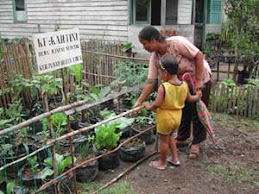Go organic
By HILARY CHIEW
A former real estate agent took up organic farming because it was the right thing to do.
THIS is the soil after 10 years of cultivation. You can throw any seed on it and the seed will grow,” declares Loh Siew Fook proudly. Every handful of soil he picks up bears wriggling earthworms, a barometer of healthy soil, hence healthy plants.
Next, he points to the plot where long beans are grown. “Look at the grasses. They co-exist harmoniously with the beans. With leafy vegetables, untrained eyes can’t tell the vegetables apart from the weeds,” he notes, comparing it to conventional farms that rely on chemicals to keep weeds at bay. Loh and his workers do weed the plots but as this takes time, the farm has an unkempt look.
Loh, 46, is convinced that agro-chemicals are harmful to the environment and well-being of humans that consume plants grown with this toxic input. That realisation prompted him to take up organic farming upon returning from Australia 10 years ago.

Although he had dabbled in “backyard farming” with friends over there, starting his own venture on a 3.2ha land in Semenyih, 40km from Kuala Lumpur was no plain sailing.
“It was a bad piece of land to start with. Half of the farm consisted of very poor soil. I had to treat the soil before I could start any serious farming. Plants just couldn't seem to grow. Tonnes of compost had to be brought into the farm,” he says, recalling the early years of rehabilitating the former rubber plantation and orchard.
“Many a time I wanted to give up,” confesses the former real estate agent.
After three years, he began to reap the fruits of perseverance. Athough the farm produced just enough for his family’s consumption and a bit extra for the market, he knew he had built up the ecosystem of a healthy farm. From then on, the output slowly increased to the present average of two tonnes per month. In 2000, he expanded his operation to another piece of similar-sized land leased from a friend.
Marketing, however, was a huge challenge back then. “The irregular sizes of the vegetables made them unattractive and shops were reluctant to sell them. We had to beg people to buy them. And then there was a shop that simply folded the business and the owner disappeared without paying us,” adds Loh.
Assisted by his wife Chen Hoong Meng, the couple initially sold their produce to organic shops on consignment basis. They gradually moved away from such retail outlets as these places demanded for varieties which Loh could not supply on a regular basis.
Loh’s produce is now carried in three organic shops and 11 Giant supermarkets in the Klang Valley. The supermarkets allocate a fixed space and Loh fills it up with whatever he could produce. Vegetables are usually on the shelf for four days before they’re replaced with fresh harvests. Unsold packages are donated to disabled homes and orphanages. These days, the return rates are negligible, a sign of consumers’ growing preference for organic vegetables.
Chen says packaging for the Giant supermarket are based on fixed prices but not fixed weight. The amount varies depending on harvests as the yield is reliant on the weather.
Having seen the downside of the organic movement in Australia where profit-driven entrepreneurs just cashed in on the growing demand for organic produce, Loh is determined to get his operation certified. He sees the same process taking place in Malaysia with the mushrooming of outlets selling organic vegetables from questionable sources.
His is one of two farms in Malaysia currently certified by the National Association of Sustainable Agriculture Australia (NASAA), the other being Titi Eco Farm in Negri Sembilan. Since 2005, Loh’s produce is packed into plastic bags bearing the certification logo and the tagline “Be Sure & Be Safe With LOVG” (Loh’s Organic Veg Garden).
Certification means farm are subjected to annual inspection and review by the certifier; an additional cost that some farmers could ill-afford. But Loh believes that certification is needed to give an assurance to consumers who generally pay a premium for such products.
“If more farms take up certification, the cost could be lowered as the expenses to bring in the certifier could be shared among us,” he says.
Loh’s two farms produce the optimum monthly, two tonnes each for three months in a year. For a substantial period of the year, the output is just sufficient to cover operational costs.
“The good months make up for the poor months. Organic farming is not quick money if you do it properly. We do it because it is the right thing to do,” says Loh.






